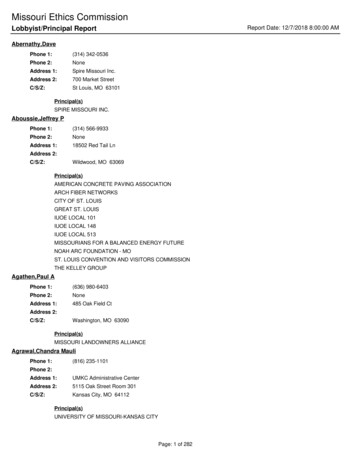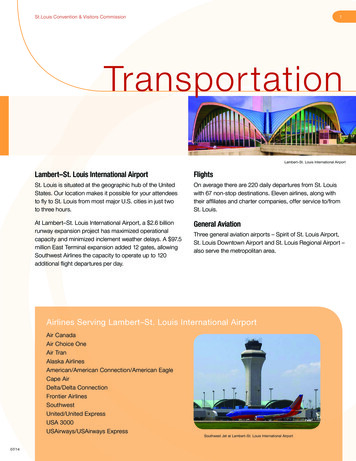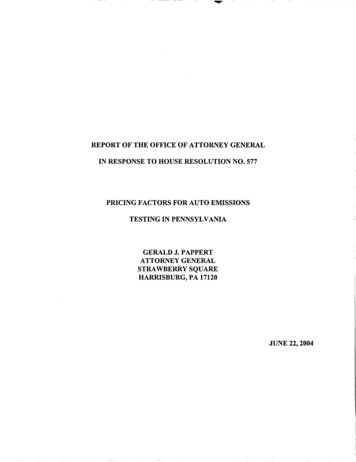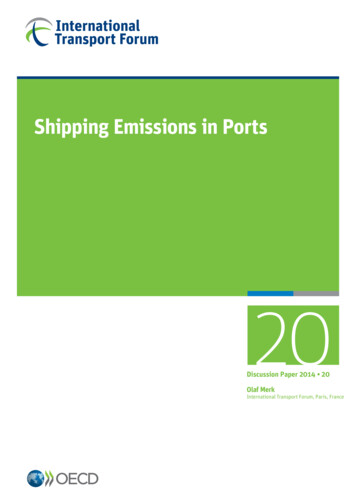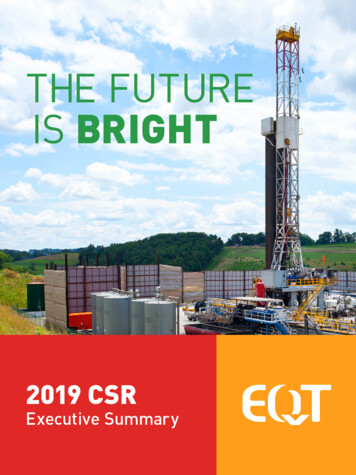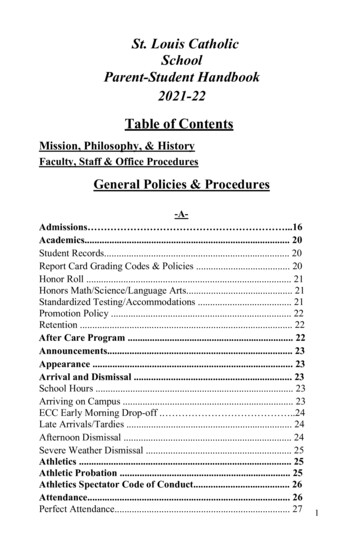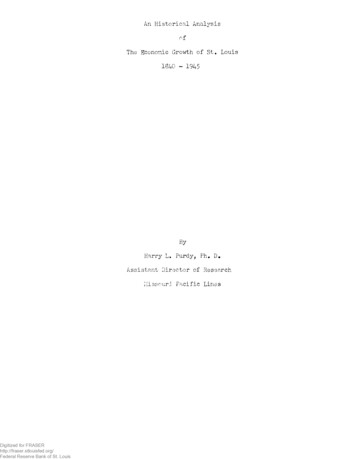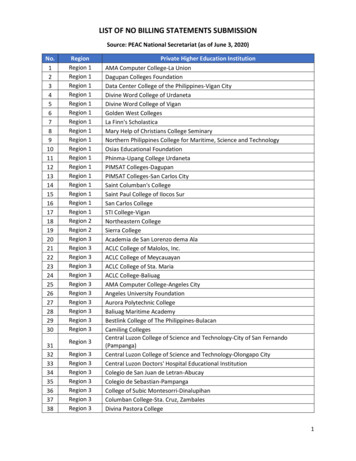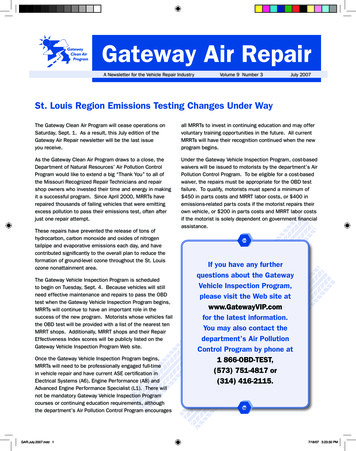
Transcription
Gateway Air RepairA Newsletter for the Vehicle Repair Industry Volume 9 Number 3 July 2007St. Louis Region Emissions Testing Changes Under WayThe Gateway Clean Air Program will cease operations onSaturday, Sept. 1. As a result, this July edition of theGateway Air Repair newsletter will be the last issueyou receive.all MRRTs to invest in continuing education and may offervoluntary training opportunities in the future. All currentMRRTs will have their recognition continued when the newprogram begins.As the Gateway Clean Air Program draws to a close, theDepartment of Natural Resources’ Air Pollution ControlProgram would like to extend a big “Thank You” to all ofthe Missouri Recognized Repair Technicians and repairshop owners who invested their time and energy in makingit a successful program. Since April 2000, MRRTs haverepaired thousands of failing vehicles that were emittingexcess pollution to pass their emissions test, often afterjust one repair attempt.Under the Gateway Vehicle Inspection Program, cost-basedwaivers will be issued to motorists by the department’s AirPollution Control Program. To be eligible for a cost-basedwaiver, the repairs must be appropriate for the OBD testfailure. To qualify, motorists must spend a minimum of 450 in parts costs and MRRT labor costs, or 400 inemissions-related parts costs if the motorist repairs theirown vehicle, or 200 in parts costs and MRRT labor costsif the motorist is solely dependent on government financialassistance.These repairs have prevented the release of tons ofhydrocarbon, carbon monoxide and oxides of nitrogentailpipe and evaporative emissions each day, and havecontributed significantly to the overall plan to reduce theformation of ground-level ozone throughout the St. Louisozone nonattainment area.The Gateway Vehicle Inspection Program is scheduledto begin on Tuesday, Sept. 4. Because vehicles will stillneed effective maintenance and repairs to pass the OBDtest when the Gateway Vehicle Inspection Program begins,MRRTs will continue to have an important role in thesuccess of the new program. Motorists whose vehicles failthe OBD test will be provided with a list of the nearest tenMRRT shops. Additionally, MRRT shops and their RepairEffectiveness Index scores will be publicly listed on theGateway Vehicle Inspection Program Web site.Once the Gateway Vehicle Inspection Program begins,MRRTs will need to be professionally engaged full-timein vehicle repair and have current ASE certification inElectrical Systems (A6), Engine Performance (A8) andAdvanced Engine Performance Specialist (L1). There willnot be mandatory Gateway Vehicle Inspection Programcourses or continuing education requirements, althoughthe department’s Air Pollution Control Program encouragesGAR.July.2007.indd 1If you have any furtherquestions about the GatewayVehicle Inspection Program,please visit the Web site atwww.GatewayVIP.comfor the latest information.You may also contact thedepartment’s Air PollutionControl Program by phone at1 866-OBD-TEST,(573) 751-4817 or(314) 416-2115.7/18/07 3:23:30 PM
Attention Dealers and Fleets: Gateway Clean Air ProgramVouchers Are ExpiringThe Gateway Clean Air Program emissions test vouchers will be expiring Saturday, Sept. 1. All motor vehicle dealers andgovernment or private fleets who have unused Gateway Clean Air Program emissions test vouchers will need to redeemtheir vouchers at any Gateway Clean Air Program testing station prior to Sept. 1, or turn in their unused emissions testvouchers for reimbursement. For reimbursement, please mail the emissions test vouchers by no later than Oct. 1 to:Gateway Clean Air Program, Attention: Voucher Return, P.O. Box 1034, St. Charles, MO 63302-1034.All Gateway Clean Air Program emissions test voucher refund requests must include a dealership or fleet manager contactname, mailing address and phone number, as well as the total number of vouchers being returned. Also, please includeyour unused portion of emissions test vouchers in the envelope.Gateway Vehicle Inspection Program: WAIVER CRITERIAAs of Sept. 1, 2007, all 1996 and newer gasoline powered and 1997 and newer diesel powered vehicles will betested using the OBDII system. Currently, 97 percent of all initially failing vehicles are repaired and able to pass anemissions retest. Those vehicles that are not repaired to pass an emissions retest are eligible for a costbased waiver.There are three waiver options offered to vehicle owners. These include cost-based, out-of-area and reciprocitywaivers.Cost-based emissions waivers are available under these conditions: A motorist has spent more than 450 on emissions-related repairs and labor. Labor costs can only apply toward thewaiver amount if a Missouri Recognized Repair Technician performs the repairs. If an owner repairs the vehicle, they must spend at least 400 in qualified emission-control parts toward the waiveramount. If vehicle owners are financially dependent solely on state and federal disability benefits or other public assistanceprograms and anticipate failing the emissions test, they may receive a waiver. The vehicle owner must providereasonable and reliable proof to the department 30 days in advance of their vehicle’s anticipated failure. The vehicleowner must spend at least 200 on emissions-related repairs and labor to qualify.Out-of-area waivers are available under these conditions: If a vehicle is registered in the St. Louis ozone nonattainment area, but operating outside of that area for the next24 consecutive months, owners may apply to the department for an out-of-area waiver.Reciprocity waivers are available under these conditions: If a vehicle is in a state other than Missouri and that state conducts pass/fail OBD testing, the motorist may chooseto have the vehicle emissions inspected in that state and submit a reciprocity waiver application to the department.To apply for emissions waivers, please visit www.GatewayVIP.com and complete the appropriate waiver requestform, or contact the Missouri Department of Natural Resources at:7545 S. Lindbergh Blvd., Ste 210, St. Louis, MO 63125 or call (314) 416-2115.The Missouri Department of Natural Resources and the Missouri State Highway Patrol jointly administer theGateway Vehicle Inspection Program. The program is a key component of the ongoing effort to improve air qualityin the St. Louis region.www.GatewayVIP.com2GAR.July.2007.indd 27/18/07 3:23:31 PM
State Awards Contract for Combined Vehicle Emissions,Safety Inspection Program for St. LouisJEFFERSON CITY, MO, MAY 30, 2007 -- The MissouriDepartment of Natural Resources has signed a contractwith SysTech International LLC to provide equipmentand data management services for the Gateway VehicleInspection Program. The program will combine motorvehicle emissions testing and safety inspections in theSt. Louis area.The contractor will provide the state with inspection andmaintenance management services, a real-time vehicleinspection database and state-of-the-art vehicle inspectionequipment and software necessary to combine emissionsand safety inspections into one program.“SysTech has offered an innovative and comprehensiveplan, and they will be a key partner in our continuingefforts to improve air quality for the citizens of theSt. Louis area,” said Department of Natural Resources’Division of Environmental Quality Deputy Director LeanneTippett Mosby. “They will provide the infrastructure fora cost-effective, convenient and fraud-resistant vehicleinspection program.”A privately owned company based in Murray, Utah, SysTechInternational is solely in business to provide vehicleinspection and maintenance services to jurisdictionsimplementing emissions and safety inspection andmaintenance programs. Inspection and maintenancecontracts in the states of Connecticut, New York (CityTaxi and Limousine Commission), Oregon, Rhode Island,Tennessee (cities of Nashville and Memphis), Utah (SaltLake County) and Washington are currently being operatedby SysTech International.The state’s contract with SysTech International is effectivefrom May 29 until Sept. 1, 2011. The contract containsoptions for one one-year or one two-year extension. Thecurrent centralized emissions only testing program, theGateway Clean Air Program, will end Sept. 1.The implementation and maintenance of the combinedemissions and safety program is designed to achievethe state’s goals of reducing ground-level ozone in theSt. Louis nonattainment area while providing maximumconvenience to area motorists whose vehicles fall underthe testing requirements. Ozone is a respiratory irritantthat can cause health problems, especially for children,the elderly and people with lung and heart diseases.“SysTech. will be a keypartner in our continuingefforts to improve air qualityfor the citizens of the St. Louisarea. They will provide theinfrastructure for a cost-effective,convenient, and fraud-resistantvehicle inspection program.”Leanne Tippett Mosby, Deputy Director,Department of Natural Resources’Division of Environmental QualityThe Missouri Department of Natural Resources and theMissouri State Highway Patrol will jointly administer theGateway Vehicle Inspection Program. For more informationabout the Gateway Vehicle Inspection Program, pleasecontact the department’s Air Pollution Control Program at1-800-361-4827 or (573) 751-4817.The Gateway Vehicle Inspection Program will cover anarea that includes the city of St. Louis, and St. Louis,St. Charles, Jefferson and Franklin counties. All 1996and newer gasoline-powered vehicles and 1997 andnewer diesel-powered vehicles under 8,500 poundsgross vehicle weight rating registered within the St. Louisozone nonattainment area will be subject to an emissionsinspection, in addition to the required safety inspection.3GAR.July.2007.indd 37/18/07 3:23:31 PM
Gateway Vehicle Inspection Program: Repair Industry FAQHow do I sign up?Shops that want to participate must fill out theMissouri Station Equipment and Service AgreementContract. The contracts are available on the Web atwww.GatewayVIP.com.Applications will also be mailed upon request. Contractsmust be completed and returned to SysTech InternationalLLC. The mailing address and fax number are locatedon the last page of the contract. SysTech will processapplications in the order they are received. Once processedSysTech will contact your shop to set up a training session.Shops were encouraged to sign up by the end of June. Ifshops missed the June deadline they can still sign up, butthey may not be up and running by Sept. 4.How much does the equipment cost;what does that include?The cost to purchase the equipment is 2,495 and isexempt from state sales tax. This includes all standard andoptional equipment maintenance for the life of the contract.The standard equipment includes a computer with a 17”LCD monitor, keyboard and mouse, one inkjet printer toprint vehicle inspection reports and one sticker printer.You will also receive a barcode reader, an OBD vehicleinterface cable, an OBD verification tool, a high-resolutiondigital camera and dock, a USB Web camera, USB driveand a fingerprint scanner. All of the equipment withthe exception of the monitor will fit inside the standardcabinet, which is also included in the base price. Thestandard equipment listed above is all that is necessaryto participate in the Gateway Vehicle Inspection Program,however optional upgrades are available, see the contractfor additional options.Why do I need a fingerprint scannerand cameras?The fingerprint scanner and cameras are security featuresfor the Gateway Vehicle Inspection Program. The fingerprintscanner will ensure that licensed inspector/mechanicsare the only employees performing the emissions andsafety inspections. The fingerprint scanner will also saveGAR.July.2007.indd 4The cameras will ensure the integrity of the program.The digital camera will be used to take pictures of thevehicle’s odometer, license plate and VIN number for boththe combined test and safety only inspections. The Webcamera is permanently connected to the computer via USBconnection and will be mounted on top of the analyzer.As appropriate, the Web camera will allow for optionalvideo monitoring and recording of additional images of theinspection process to ensure the integrity of the program.Do I have to choose options now or can I choosethem at a later date?You may choose additional equipment options later;however, the price of the optional equipment may increaseif it is ordered outside of the initial service contract.And while you are not required to choose any additionaloptions, the all-inclusive warranty upgrade can only bechosen in the initial service contract. The warranty optionis not available to you once you receive your equipmentand begin operation.What does the all-inclusive warrantyupgrade cover?The all-inclusive warranty upgrade includes allconsumables, free delivery of all consumables and fullcoverage for any equipment damage during the term ofthe contract. This warranty is available for an additional 50 per month, and must be chosen in the initial servicecontract.FAQWhat are the cabinet dimensions in thestandard package?The standard cabinet is approximately 3 feet high by 2 feetsquare. It is equipped with a lock and all of the equipmentwill fit inside the cabinet with the exception of the computermonitor, which will be located on top of the cabinet. It willalso be on casters so that the OBD equipment can berepositioned if necessary.4time by simply allowing the inspector to place a finger onthe scanner, rather than requiring them to type numerousidentification codes to access the required information.Are payment options available when I orderthe equipment?Yes. There are four payment options available. Option1 is payment in full for all ordered equipment. Option2 is 500 down and the remaining balance due upondelivery of the equipment. Option 3 is 1,247 (half) downand the remaining balance due in equal installments of 100 for 24 months. Option 4 is no money down and thebalance due in equal installments of 100 for 48 months.Please note that if you choose option 3 or 4, any optionalequipment that is ordered must be paid for in full at thetime of delivery.Are there other costs for participation?Yes. Participating shops must be licensed by the state.The cost of the station license is 100 per year. Safety7/18/07 3:23:32 PM
inspection station licensing fees will remain the same at 10 per year. There is also a 4.00 sticker/authorizationfee and a 3.45 Vehicle Inspection Database servicefee. The sticker fee is divided between the MissouriDepartment of Natural Resources and the Missouri StateHighway Patrol. The 3.45 Vehicle Inspection Databaseservice fee is paid to SysTech for each combinedinspection. The service fee is charged only when it is apaid inspection for the shop, qualifying free reinspectionswill not incur this charge. There is also no service feecharged when the shop performs a safety only inspectionfor a vehicle.What happens if I run out of stickers?Shops will prepurchase stickers that give authorizationto perform emissions tests or safety inspections. Yourshop will be locked out of the system if you run out ofauthorizations. Shops can set their equipment to notifythem to reorder when their authorizations are getting low.How are Vehicle Inspection Database servicefees billed?At the end of the month an electronic invoice will be sentto your computer. This electronic invoicing will allow shopsto review their charges instantly. Service fees can be paidby check, charge or through a direct debit from a bankaccount. If you are delinquent in making this payment,your shop will be locked out of the system until payment isreceived.Why do I pay a Vehicle Inspection Databaseservice fee?The service fee allows SysTech to maintain the electronicdatabase that stores all vehicle inspection informationand makes the information readily available to both theshop and the state. This fee includes software upgradesas well as service calls and technical support to any of theshops. There will be no additional charge for the softwareupgrades.What are the costs for technical support orservice calls?Technical assistance and service calls are free of charge.SysTech will determine the appropriate assistance optionfor each shop based on their specific need. These servicesare provided to the shops for the life of SysTech’s contract.What if the equipment I ordered does notoperate properly?Contact SysTech immediately for all software and hardwareproblems. SysTech personnel will determine the bestcourse of action for each situation. SysTech is required tomaintain an average service response time of four hoursor less by contract.Is a dedicated bay required to performemissions testing and safety inspections?No. Shops may perform emissions testing and safetyinspections in different bays as long as those baysare inspected and approved by the Missouri StateHighway Patrol.Is a dedicated phone line required to connectto the Internet?Yes, if the shop uses a dial-up Internet connection. If theshop uses a high-speed Internet connection during itsday to day business, a router will be required to maintainconnection to the testing equipment. Wireless connectionsare also available, see the contract for details.How many days per week am I requiredto perform emissions testing and safetyinspections?As required by law, any shop that performs emissionstesting and safety inspections must operate at leastfive days per week. Those five days do not have to beconsecutive. A day of operation should be at leasteight hours.How much can I charge my customers foran emissions test?If a shop performs both a safety inspection and anemissions test for a customer, the most that they cancharge is 36. If a customer fails one or both tests theyare entitled to one free retest at the shop that performedthe inital test as long as they return within 20 businessdays. State law caps the emissions test fee at 24.Safety inspections fees are capped by state law at 12.How long does it take to complete anemissions test?The emissions test takes approximately three minutesto complete.How can shops help inform the public of thechanging emissions testing procedure?The Missouri Department of Natural Resources hasestablished a Web site to help inform the shops and thepublic about the Gateway Vehicle Inspection Program atwww.GatewayVIP.com. The Web site includes frequentlyasked questions and other helpful information to aidmotorists during this transition. For more information,shops can direct their customers to the Web site or theymay call 1-866-OBD-TEST (623-8378).For more information call or write: Missouri Department of Natural Resources, Gateway Vehicle Inspection Program, St. Louis Regional Office, 7545 S. Lindbergh, Suite 210,St. Louis, MO 63125, (314) 416-2115 office, (314) 416-2970 faxGAR.July.2007.indd 557/18/07 3:23:32 PM
Auto Shops Continue to Sign Up for the New Gateway VehicleInspection Program in St. Louis AreaJEFFERSON CITY, MO, JULY 2, 2007 – As of today, 563auto shops have signed up to join the Gateway VehicleInspection Program in the St. Louis area according tothe Missouri Department of Natural Resources.SysTech International LLC encouraged shops to applyby the end of June to receive all required equipment,training and licensing by September. SysTech willcontinue to process applications received after June 29,however, those shops may not be up and running by thestart of the new program.Currently, there are approximately 1,100 licensedsafety inspection stations in the St. Louis ozonenonattainment area, which includes the city ofSt. Louis and Franklin, Jefferson, St. Charles andSt. Louis counties. Those stations are eligible to signup for the Gateway Vehicle Inspection Program.“I’m pleasedwith the numberof applicationsreceived to date.The GatewayVehicle InspectionProgram would like to encourage allcurrently licensed safety inspectionstations to continue to sign up for theprogram.”Leanne Tippett Mosby, Deputy Director,Department of Natural Resources’ Division ofEnvironmental Quality“In a relatively short amount of time, SysTech hasaccepted hundreds of applications to join the program,”said Department of Natural Resources’ Division ofEnvironmental Quality’s Deputy Director Leanne TippettMosby. “I’m pleased with the number of applicationsreceived to date. The Gateway Vehicle InspectionProgram would like to encourage all currently licensedsafety inspection stations to continue to sign up forthe program.”SysTech, the Department of Natural Resources andthe Missouri State Highway Patrol recently held threeinformational seminars in the St. Louis area. Staffprovided information and applications to interested autoshops and answered questions on the new GatewayVehicle Inspection Program. Approximately 700 peopleattended the information seminars.SysTech will provide equipment and data managementservices for the program. After registering with SysTech,auto shops will apply to the Missouri State HighwayPatrol for an emissions inspection license. Thecontractor will train the emissions mechanics. Oncethe training is complete, the inspector/mechanicsmust pass a written and practical exam offered by theMissouri State Highway Patrol. For more informationabout participating in the Gateway Vehicle InspectionProgram or to apply, auto shops can visit the Webat www.GatewayVIP.com or call 1-866-OBD-TEST(623-8378).The Gateway Vehicle Inspection Program is jointlyadministered by the Missouri Department of NaturalResources and the Missouri State Highway Patrol. Theprogram is a key component of the ongoing effort toimprove air quality in the St. Louis region.For news releases on the Web, visit:www.dnr.mo.gov/newsrel.For a complete listing of the department’s upcomingmeetings, hearings and events, visit the department’sonline calendar 7.indd 67/18/07 3:23:33 PM
More States Are Using OBD for Vehicle Inspection andMaintenance Programs Reprinted with permission from the U.S. Environmental Protection Agency.Vehicle inspection and maintenance(I/M) programs are adopting state-of-the-arttechnology for model year (MY) 1996 andnewer vehicles.The Clean Air Act requires inspection and maintenance(I/M) programs to incorporate on-board diagnostic (OBD)testing as part of vehicle emission inspection. A majority ofthe 33 state and local areas that require vehicle emissiontests have now moved forward to incorporate the use ofOBD technology for vehicle inspections.OBD is designed to monitor vehicle operation and detectproblems as soon as they occur. Early detection ofproblems makes warranty coverage programs moreeffective. Detecting and repairing problems early can alsoprevent more costly repairs later. OBD provides specificinformation to refer the repair technician to the properrepair procedure.BackgroundThe current fleet of more than 200 million vehiclesdriving on U.S. highways is a major source of air pollution,accounting for approximately 77 percent of the carbonmonoxide and 45 percent ofthe nitrogen oxides in ournation’s air. If not properlymaintained, these vehicles“For motorists, OBD checks arewill not perform as originallya simple and convenient methoddesigned, causing them toof identifying vehicles in need ofwork harder, wear out faster,and pollute more.repair. On the national and localJeff Holmstead, AssistantAdministrator of EPA’s Officeof Air and Radiation, observesthat, “I applaud the states thatare conducting OBD checks toimplement what EPA hasdetermined to be a reliableI/M test for 1996 and newerToday’s vehicles are highlylevel, OBD is an important tool invehicles. For motorists, OBDsophisticated and highlychecks are a simple andimproving air quality and helpingefficient. All 1996 and newerconvenient method of identifycars and trucks have anstatestomeetNationalAmbienting vehicles in need of repair.advanced powertrain controlAir Quality Standards.”On the national and local level,computer which uses secondOBD is an important tool inJeff Holmstead,generation OBD technologyimproving air quality and helpingAssistant Administrator,to manage and monitor thestates to meet NationalEPA Office of Air and Radiationoperation of the engine andAmbient Air Quality Standards.”transmission. This computer isThe OBD check efficientlyfaster and more powerful thanincorporates the capabilitiesa space shuttle’s navigationof the OBD system to speed thecomputer. It keeps your engine running at peak efficiencytesting process, provide specific information to theand will alert you to any potential emission problems.technician to help get repairs done correctly, and maximizethe air quality benefits of an I/M program.I/M programs have been in place in state and local areasThe real-world experiences of states already using OBD intheir inspection programs, coupled with EPA studies, arehighlighting the benefits of OBD testing and providing uswith additional hard data that supports inclusion of OBDinto operating programs. OBD offers significant air qualitybenefits, short inspection time for the consumer, and anaccurate diagnosis of needed repairs. Repair costs ofOBD-failed vehicles are comparable to that of traditionaltailpipe tests.for many years to help identify vehicles that are in need ofrepair and therefore exceeding emissions standards. OBDis available only on model year 1996 and newer vehicles.A significant, but declining, portion of the fleet is stillpre-1996. EPA will continue to support traditional tailpipetesting and will continue to monitor OBD’s performance asvehicles age.For more information on OBD and vehicle I/M programs,visit EPA’s Web site at www.epa.gov/otaq/obd.htm.7GAR.July.2007.indd 77/18/07 3:23:33 PM
Gateway Air RepairPO Box 1034St. Charles, MO 63302-1034yto annorspasepaieRsdaeealifi. Pls.post nized/Qu s addresPlease ri Recog ng at thiouorkiMissns waicinPrinted on recycled paperTechthis newsletterGATEWAY VEHICLE INSPECTION PROGRAMOBD-II Pass/Fail Test Criteria (On-board Diagnostics, Generation II)KOEOBULB CHECKKOERMIL COMMANDEDCODES PRESENTREQUIRED # OFMONITORS SET F---NOFAILONOFFPREVIOUSCATALYST CODECATALYST MONITORNOT SET TO READYFAILONOFF---YESPASSREADINESS1996-2000 Model Year: Allowed 2 non-continuous monitors not set to ready(3 or more and vehicle will fail)2001 & Newer Model Year: Allowed 1 non-continuous monitor not set to ready(2 or more and vehicle will fail) A vehicle with an OBD test failure for any catalyst code (P0420-P0439) must have the catalyst monitorset to ready for retest All gasoline-powered vehicles must have the oxygen sensor and catalyst monitor supported.GAR.July.2007.indd 8PASS B ulb Check for MalfunctionIndicator Light (MIL)- MIL illuminated inKOEO - key-on/engine-offcondition- MIL not illuminated in KOER- key-on/engine-runningcondition MIL not commanded on Readiness status OKFAILURE Bulb Check- MIL does not illuminate inkey-on/engine-off condition- MIL illuminated in key-on/engine-running condition MIL commanded on DLC missing, tampered orinoperable No communication/response from vehicle Too many unset readinessmonitors7/18/07 3:23:34 PM
Lake County) and Washington are currently being operated by SysTech International. The state's contract with SysTech International is effective from May 29 until Sept. 1, 2011. The contract contains options for one one-year or one two-year extension. The current centralized emissions only testing program, the
